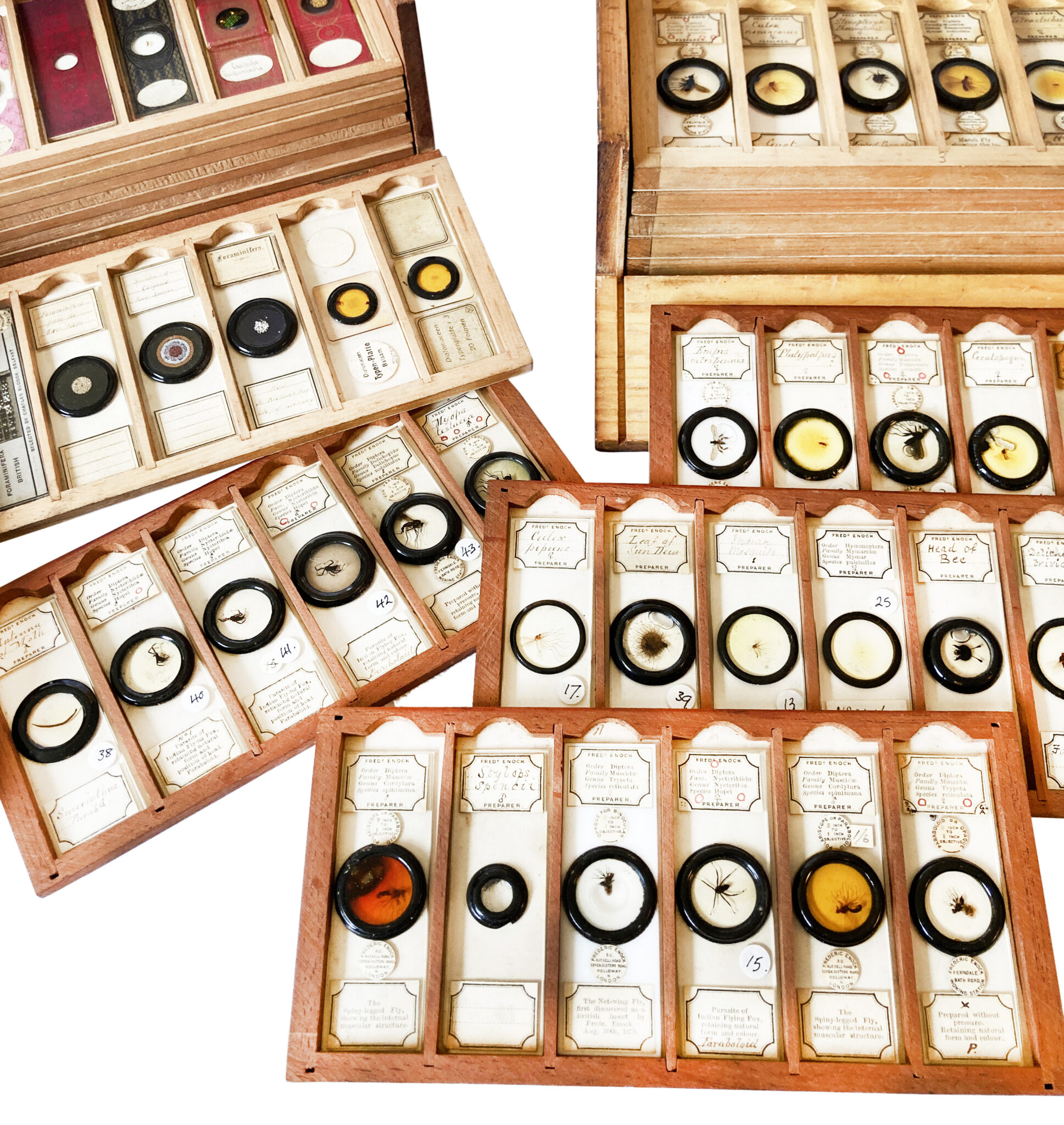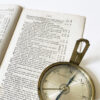The Fred Enock collection: historically important late 19thC microscope slides and archive
Stock Number: 2410X
POA
An exceptional collection of almost 300 entomological and other microscope slides from the personal collection of Fred Enock (1845–1916), with associated archival material and lantern slides
Circa
1880–1910
Maker
Fred Enock
Country of manufacture
UK and Ireland
Description
“A perfection which has never been equalled”
An extensive collection of microscope slides, magic lantern slides, and associated archival material
Frederic Enock (1845–1916), and others; c.1880–c.1910
Physical description 299 slides contained in four Victorian pine slides cabinets (one with name F Enock to interior of lid), and four modern card boxes [together with:] 18 magic lantern slides, negatives of Enock drawings [together with:] an archive of letters and other documents relating to Enock’s work Of the 298 slides, 109 bear Fred Enock’s trade labels; another 33 unfinished and attributed to Enock. 12 slides bear the label of John K. Enock (1878–1957) 215mm x 215mm x 80mm (largest box) Notes An exceptional and historically important group of microscope slides, from the working collection of Fred Enock (1845–1916), with associated archival materials, and a group of lantern slides. Fred Enock was the pre-eminent entomological microscope slide mounter of his day. In his 1992 presidential address to the Quekett Society, B.M. Davidson stated that
When you first hold a Fred Enock slide in your hand, it is impossible not to notice the skill and precision of the mounting. Whether the label is hand-written or printed, the overall impression is of superlative craftsmanship. Closer inspection confirms this. Every part of the insect is prepared and arranged to display it to the very best advantage. No matter how delicate the subject, a Fairy fly or a gnat, it is arranged with a perfection which has never been equalled. It was not a matter of chance whether one bought a ‘good’ Enock slide, no mount was sold which in any way failed to measure up to his standards of perfection.
Enock trained with his uncle Edmund Wheeler, one of the most successful microscope slide mounters of the Victorian era. Unlike Wheeler, Enock decided to specialize, working throughout his life to perfect entomological preparations, and specializing even further in the tiny ‘fairy flies’ (Mymaridae), amongst which can be found the smallest insects and smallest flying insect. Enock was the only slide preparer to offer Mymaridae, and his monograph on the family was never produced; the present collection therefore must count as the ‘archive’ of his unique interest in this highly specialized area of entomology.
The earliest dated slides here were mounted c.1880, shortly after Enock had set up his own business; the latest date on an Enock slide is 1910, when he records that he has successfully bred the fairy fly Mymar pulchellus (see his published report in Knowledge, July 1910). Some of the finest slides preserved here are those mounted ‘without pressure’, intended to be viewed with polarized light, and offered unpriced in Enock’s catalogue. Many have revealing manuscript notes on them, some indicating that they have been lent out, others noting the mounting date and giving other entomological information. A group of unfinished slides may reveal the working practices of Enock.
Another group is signed ‘J.K. Enock’. This is John (Jack) Kemp Enock, Fred’s nephew, whom he trained in fairy-fly collection and mounting. Accompanying these slides is a group of letters from Fred Enock to Jack, touching on many matters of slide preparation. As Enock’s personal and business archives were destroyed after his death, these letters are the sole written source for information on Enock’s technique. Also offered are the maps used by Enock while travelling (largely by rail) on collecting trips.
Lastly, we offer 18 lantern slides from Fred Enock’s collection, showing photographs of his exceptional drawings of microscopic preparations.
Provenance Fred Enock, and thence by descent.
Literature B.M. Davidson, ‘Fred Enock 1845–1916 – The Man and His Work’, Microscopy, 36 (Autumn, 1992), pp. 657–674 See also: https://microscope-antiques.com/fairybeetle.html
Condition The condition of the slides is generally excellent; two Enock slides are damaged, not affecting the preparations; the liquid in some slides is discoloured, and about a dozen of Enock’s slides have varnished labels, with the varnish somewhat yellowed. The non-Enock slides are also generally in excellent condition, barring about 10 which are either damaged, missing cover-slips or otherwise compromised. Letters and maps in very good condition; lantern slides very good, though one is damaged.
Ask the Dealer
Dealer information
 Fleaglass-Commission-Sale
Fleaglass-Commission-Sale
In addition to displaying the stock of all the dealers listed below, Fleaglass also sells selected antiques on behalf of collectors and other private individuals. Every item is carefully examined for authenticity and condition, and only items meeting our high standards are accepted. All commission items are offered with a money-back guarantee. Please click on the image on the left to see the current items.



















